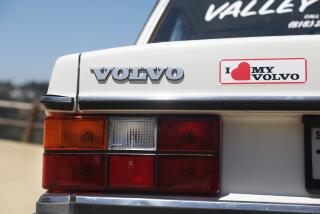His Love of Trucks Is Tested by a Storm and Drags on the Engine
Iâve always liked trucks. The bigger, the better.
I hauled oranges as a teenager, but none of the trips was more than 150 miles. Later, as an adult, I owned a small avocado grove. That justified buying a truck of my own, but it was only a pickup.
So when my wifeâs parents--now well into their 90s--finally decided last fall that it was time to move to a retirement home, opportunity smiled.
Their new apartment, while comfortably spacious by most standards, is about half the size of the house they were leaving on the North Shore of Chicago. That meant they would have to part with a truckload of stuff accumulated during 60 years of marriage. A big truckload.
There were some nice tables, chairs, couches and beds, and some useful things like andirons and watering cans. There were other things too, like a scratched-up, â40s-vintage radio-phonograph cabinet lacking both the radio and phonograph, and a nondescript shotgun that doesnât work anymore.
It was up to their daughter, Martha, and me to deal with all that stuff, and the simplest solution seemed to be to load it all in a rental truck and haul it to our home on the outskirts of Los Angeles.
Consultations with the folks at Ryder led us to settle on the largest vehicle theyâll rent to ordinary folk--people, like me, who donât have a commercial chauffeurâs license.
It was a 30-foot-long, diesel-engined moving van rated at 23,500 pounds gross weight--just a shade under 12 tons. As a concession to its driver, the truck had a radio and an automatic transmission. As a concession to all the other drivers, it was painted bright yellow, so they can see you coming.
*
Thus it was on a cold, overcast November morning that my truck and I lumbered out of a driveway in Glencoe, Ill., for what would be a five-day, 2,160-mile trek to Altadena. Martha, who has a good deal of common sense, had elected to fly back to California. I was on my own.
Getting out of the Chicago area took me awhile. To avoid tolls, I used surface streets, which led to some missed turns. Missed turns in a truck thatâs as long and wide as a city bus--and a good deal taller--can be problematical, since U-turns and even right and left turns on narrow suburban streets are virtually out of the question.
Nonetheless, after an hour or so, I found myself headed west for what would be the better part of four days on Interstate 80.
I quickly discovered that concrete highways--which are built in a series of short strips laid at right angles to the roadway--can set up a sympathetic vibration in long trucks that bounces them up and down like dribbled basketballs.
Physicists say that higher speeds would cancel out the vibrations, but my truck was equipped with an engine governor that limited the top speed to about 60 mph.
That meant greater safety and less strain on the engine. It also meant that--in addition to having to live with the bounces--I had limited power available for climbing steep grades. In that entire 2,160 miles, I passed a total of perhaps a dozen vehicles--most of them worn-out motor homes driven by octogenarians. I was passed by thousands.
Fortunately, the interstates are getting old, and a lot of the resurfacing has been done in asphalt. Asphalt may be uglier than concrete, but itâs a lot smoother.
During one of those smoother stretches, I had time to peruse some of the warning signs plastered all over that truck. They advised me to obey all traffic laws, watch all clearances and monitor carefully the dashboardâs array of gauges and warning lights.
Five minutes later, a yellow warning light informed me that the electrical brake pump was on.
At first, that seemed reassuring. The light at least meant that the air brakes were working.
About two hours later, I was passing through the outskirts of Iowa City, Iowa, when I spotted a roadside motel with a big parking lot--important when driving a 30-foot truck. I decided to call it a day.
*
But the yellow warning light was still on, which didnât seem so reassuring anymore. And when I turned off the engine, I could hear an ominous whining noise. The pump was still running.
That meant two things could happen, both of them bad. Either the pump would run until it burned out, or the battery would die. Not only that, it was beginning to rain, hard, and the wind was starting to blow, equally hard.
I called Ryder, and the company sent a repair truck down from Des Moines. Three hours later, a chilled and drenched repairman said the problem--apparently a loose wire--had been found and fixed. I went to bed.
By dawn, the wind gusts were up to 50 mph and the rain had been replaced by snow flurries. Television stations reported an intensifying winter storm--one that would make national news broadcasts for the next two days. Trucks were being blown over in Minnesota.
But the yellow light was off, and the worst of the storm seemed to be to the north. I clambered back up into my truck and headed out again.
The winds continued to increase, but they were mostly head winds from the west. I had to wrestle constantly with the steering wheel, but the main effect of the wind was to slow me down, to about 35 mph. Then, as I headed south briefly near Council Bluffs, Iowa, a powerful gust hit the truck broadside.
The truck leaned but stayed on course. Suddenly, 35 mph seemed plenty fast enough. A few hundred yards down the road, I saw an overturned tractor-trailer rig. I stopped and had a cup of coffee.
After a comfortable night at a motel in Grand Island, Neb., I hit the road again. The sun broke through the clouds, the winds abated, and all was right in the world. I ate four doughnuts to celebrate.
Then the yellow light came back on. My maps showed the next sizable town was North Platte, Neb., and when I arrived there about 90 minutes later, I found the local Ryder office.
âTwo possibilities,â the Ryder agent said. âEither itâs the main pump shaft, which we canât fix here, or itâs the relay switch, which we can replace in two minutes.â
Ever the pessimist, I figured it was the shaft, which could mean two more days in ever-fascinating North Platte. But it was the relay.
*
Back on the road, I exulted. The truck was now a familiar friend, one that had repeatedly survived adversity. The engine snorted cheerfully as I topped the 8,640-foot pass in Wyoming between Cheyenne and Laramie, and I felt like an accomplished knight of the highways as I wheeled up between two massive semis at a truck stop near Elk Mountain, Wyo., to fill up my 50-gallon fuel tank.
As one of the other drivers ambled over to speak to me, I felt proud to be recognized as one of the guys.
âHey, feller,â he said. âLittle trucks like yours can fill up at the pumps out front.â
But the illusion had been good while it lasted. And that night, at a motel in Rawlins, Wyo., I fell asleep contentedly to the sound of freight trains rumbling by along the first rail line to span the nation. I was more than halfway home.
The next day--my longest--I made almost 600 miles, first west along I-80 to Salt Lake City, then south along I-15 to St. George, Utah. The day was uneventful, and even a little boring. I had to admit that being a newspaper reporter--which is what I do for a living--is really a lot more stimulating than driving a truck. Not as honorable, perhaps, but more interesting.
I drove downgrade through Arizonaâs spectacular Virgin River gorge at dawn the following day, arriving in Las Vegas just in time for the morning commuter crunch. Finally free of traffic, I made the final run to Altadena in another five hours.
Martha had preceded me home, and it was only then that we began facing up to what to do with all that stuff.
Some of it, of course, has been welcomed into our house. Some of it--six beds, the shotgun, a hoe and a set of fire tongs--went to two men who helped us unload the truck. My sister took a watering can. But about half the stuff ended up in our garage, where it awaits the pleasure of our children, who may, or may not, decide to offer some of it a home.
There are other items--two chairs oozing stuffing, an 8-foot sleeper couch, an old brass fireplace fender--that Martha talks vaguely about selling. As though she could find a buyer.
After I turned the truck in to the Ryder agency in Pasadena, I told everyone that I was glad the trip was over--that I probably wouldnât do anything like that again.
But I would.
Because I still like trucks.
*
Eric Malnic is a reporter on The Timesâ Metro staff. He can be reached at [email protected].






